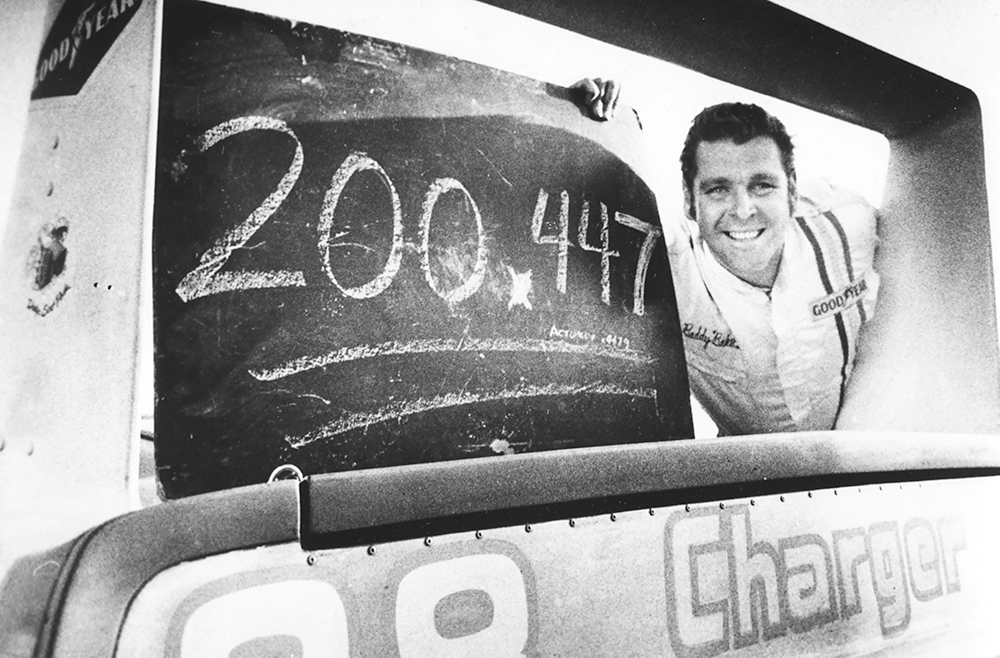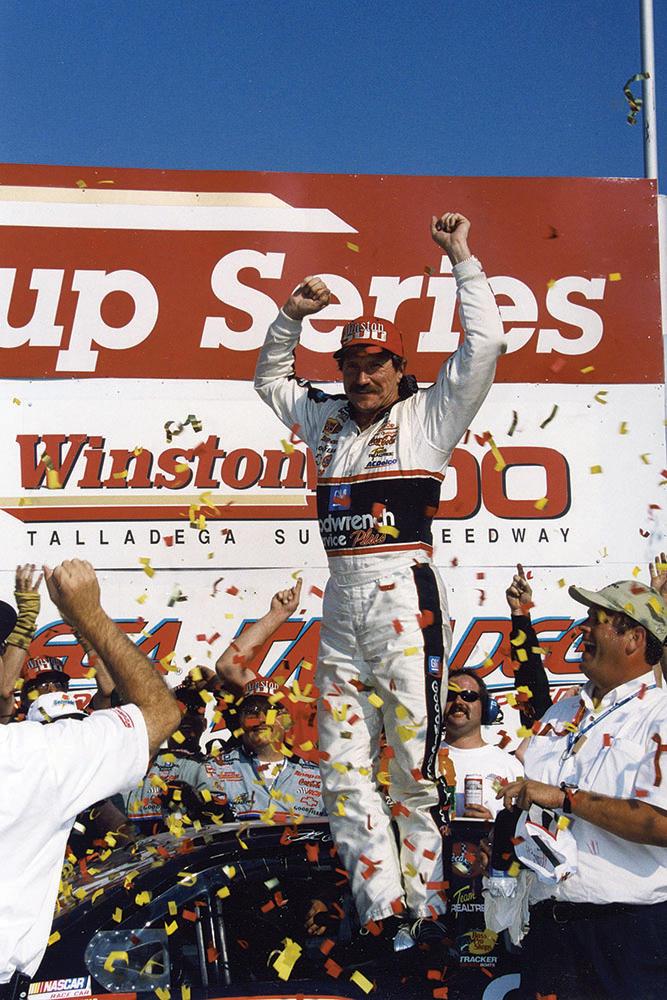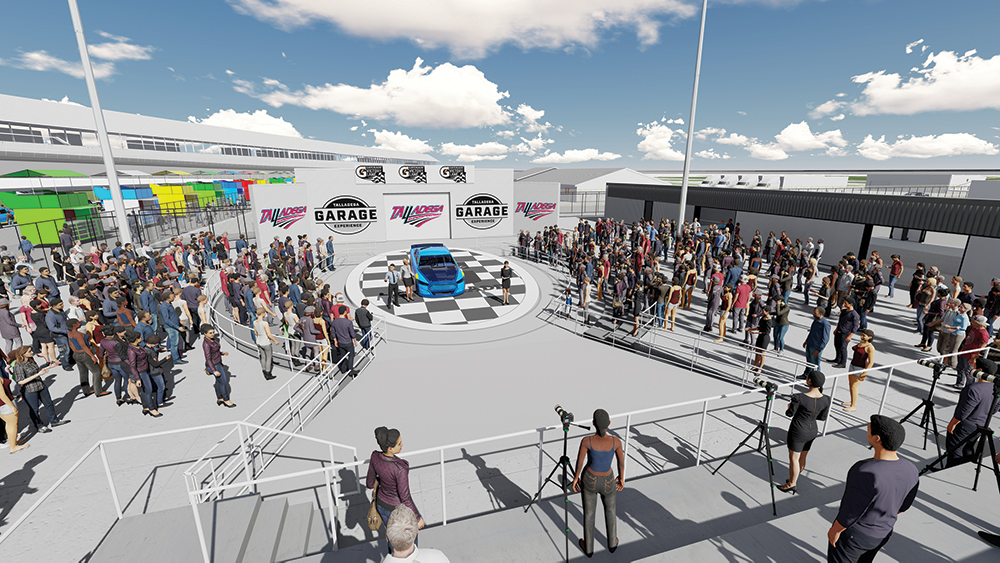Fans can meet legendary drivers and see iconic cars Oct. 11-13
By John N. Felsher

Five decades ago, William “Big Bill” France looked for a new place where drivers could race. France, a former racer himself, helped found the National Association for Stock Car Auto Racing in 1948 and created the Daytona International Speedway in Florida in 1959.
“Big Bill wanted something bigger, faster and wider than Daytona,” says Russell Branham, the Talladega Superspeedway public relations director. “He wanted to create the ‘palace of speed,’ where drivers could go faster than at Daytona and have more room to pass or maneuver.”
France enlisted the help of Bill Ward, an Anniston insurance man, to look for suitable land with enough acreage to build a racetrack close to a major highway. Ward found the deactivated Anniston Air Force Base between Anniston and Talladega.
“Bill Ward was very instrumental in bringing the racetrack here,” Branham says. “He believed it would be an incredible economic boost to this area and the entire state. He was right. Each year, our races bring in about $434 million to the state of Alabama.”

Ground broke on the 2,000-acre site on May 23, 1968. The new 2.66-mile long Alabama International Motor Speedway included embankments rising five stories high at 33 degrees. In 1989, the name changed to the Talladega Superspeedway.
The first race, the “Bama 400 Grand Touring Race,” ran on Saturday, Sept. 13, 1969. Ken Rush drove his Camaro to victory. However, that race was only a warm-up for the first main event – the Talladega 500 scheduled to run the next day.
“Leading up to the big race in 1969, most of the drivers felt like their tires would not last through the entire race,” Branham says. “Many big-name drivers pulled out of the race on Saturday because they didn’t think they could run at those speeds for 500 miles on those tires.”
France asked the drivers who raced on Saturday to compete again on Sunday and even offered them some extra incentive money. Only 12 drivers scheduled to race on Sunday competed, but the field included 24 drivers who raced that Saturday. Richard Brickhouse won that first Talladega 500 driving at speeds approaching 200 miles per hour.
The Talladega Superspeedway saw many other great events and records set during the past five decades. In 1970, Buddy Baker became the first driver in NASCAR history to exceed 200 mph. In 1987, Bill Elliott, a NASCAR Hall of Famer, set a speed record when he drove 212.809 mph in a 1987 Ford Thunderbird.
People can see Elliott’s record-breaking Thunderbird when the Talladega Superspeedway celebrates its 50th anniversary on Oct. 11-13. That weekend, fans can see several other iconic cars and meet some legendary drivers.
“We’re going to bring back some historic cars that have made their mark here over time,” Branham says. “Dale Earnhardt won 10 times at Talladega. We’ll have one of his cars here. Will also have cars from David Pearson, Richard Petty and others. Some Hall of Fame drivers like Bobby and Donnie Allison and other great racers will be here to meet their fans.”
A $50 million facelift
Also during the 50th anniversary celebration, fans will get their first look at the $50 million renovation and upgrade to the track facilities. Announced in July 2018, the project had two phases. Phase One included building a new tunnel to allow recreational vehicles better access to the track. The project finished in April 2019.
“The racetrack has had a glorious past, but the future is extremely bright with the transformation of our infield project,” Branham says. “What we’re getting ready to unveil will set the stage for the next 50 years. With the brand-new incredibly large vehicular tunnel in Turn 3, RVers can go in and out of the racetrack throughout the race weekend as they please. Previously, once people got into the track, they were locked in until after the race. We also added new RV spots on the iconic infield.”
Most race fans stay in the area five to six days, but others arrive in RVs as much as 10 days before race day to get a good spot in the infield. During a race weekend, the local population swells by about 180,000 to 200,000 people. In contrast, Montgomery had a population of about 200,000 in 2018.

“Twice a year, we become one of the largest cities in Alabama,” Branham quips. “During a race weekend, about 73 percent of our fans come from outside of Alabama.”
Phase 2 of the project includes the Talladega Garage Experience. This will allow fans to see the drivers and their teams working in 22 garages as they prepare cars for the next race. It also includes a 35,000-square-foot Open Air Club with a giant video screen, kids’ zones, concessions and other new amenities.
“The centerpiece of our new project is the Talladega Garage Experience,” Branham says. “This will give fans a ‘locker room’ experience where they can get up close and personal with the drivers and teams working on their cars just a few feet away. Drivers and team members might walk over to the fans and sign autographs. We will also have a brand-new Victory Lane so fans can watch the end of the race from the grandstands and come down to see the Victory Lane celebration.”
At 7 p.m. Oct. 11, fans can participate in the “Big One on the Boulevard.” This includes a Mardi Gras-style parade where drivers will throw out beads and other items. Fans can also compete against each other in fun contests while drivers announce the events. On Oct. 12, race fans can attend a concert featuring Riley Green. At 1 p.m. Oct. 13, the main event, the 1000Bulbs.com 500 begins. People who buy a ticket to the Sunday race can see the Saturday night concert for free.
“Big Bill France could have built this racetrack in many other places, but he chose to build it here in Alabama,” Branham says. “The Talladega Superspeedway has been a Crown Jewel for Alabama since 1969. No other racetrack provides the excitement and incredible finishes like Talladega where multiple cars running 200 miles per hour battle for the lead. We’re proud to have been a part of Alabama history for 50 years.”
For more visit talladegasuperspeedway.com or call 877-GO2-DEGA. For tickets, call 855-518-RACE.ν





